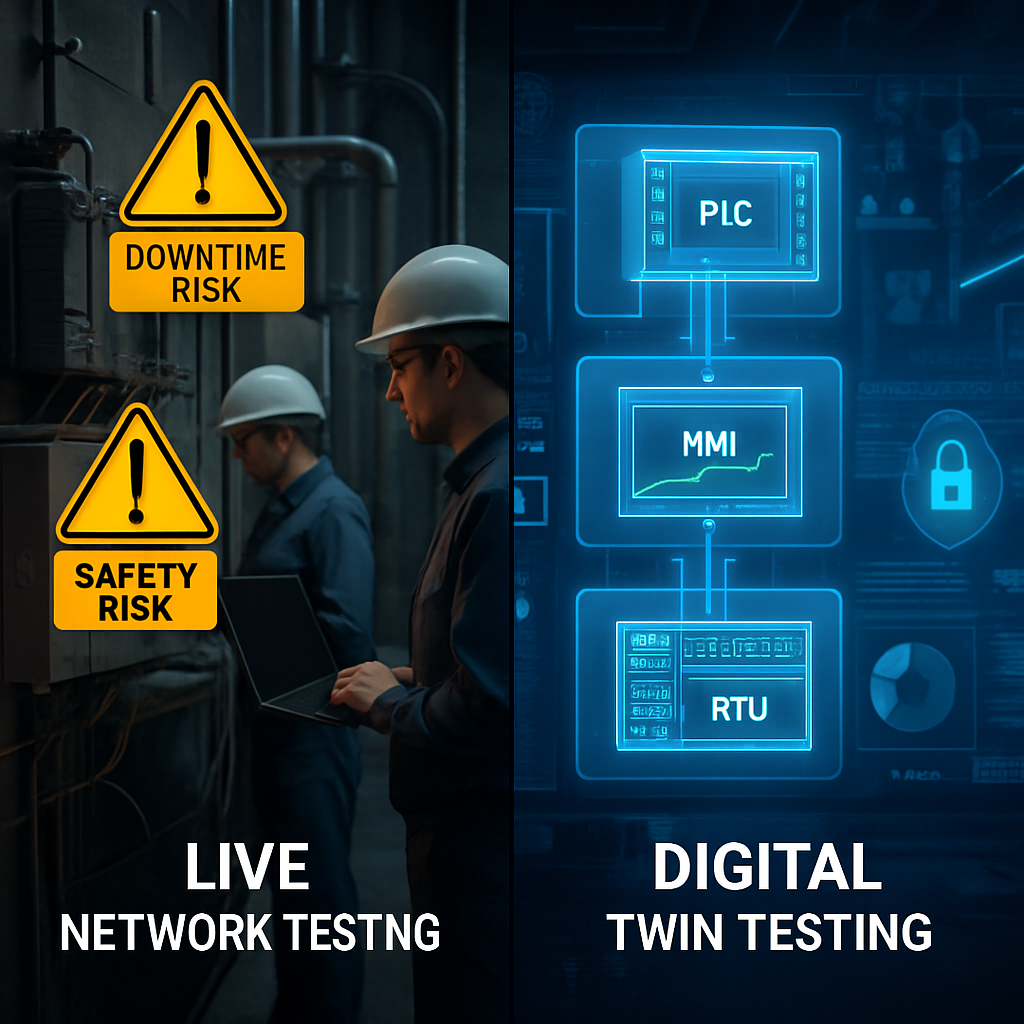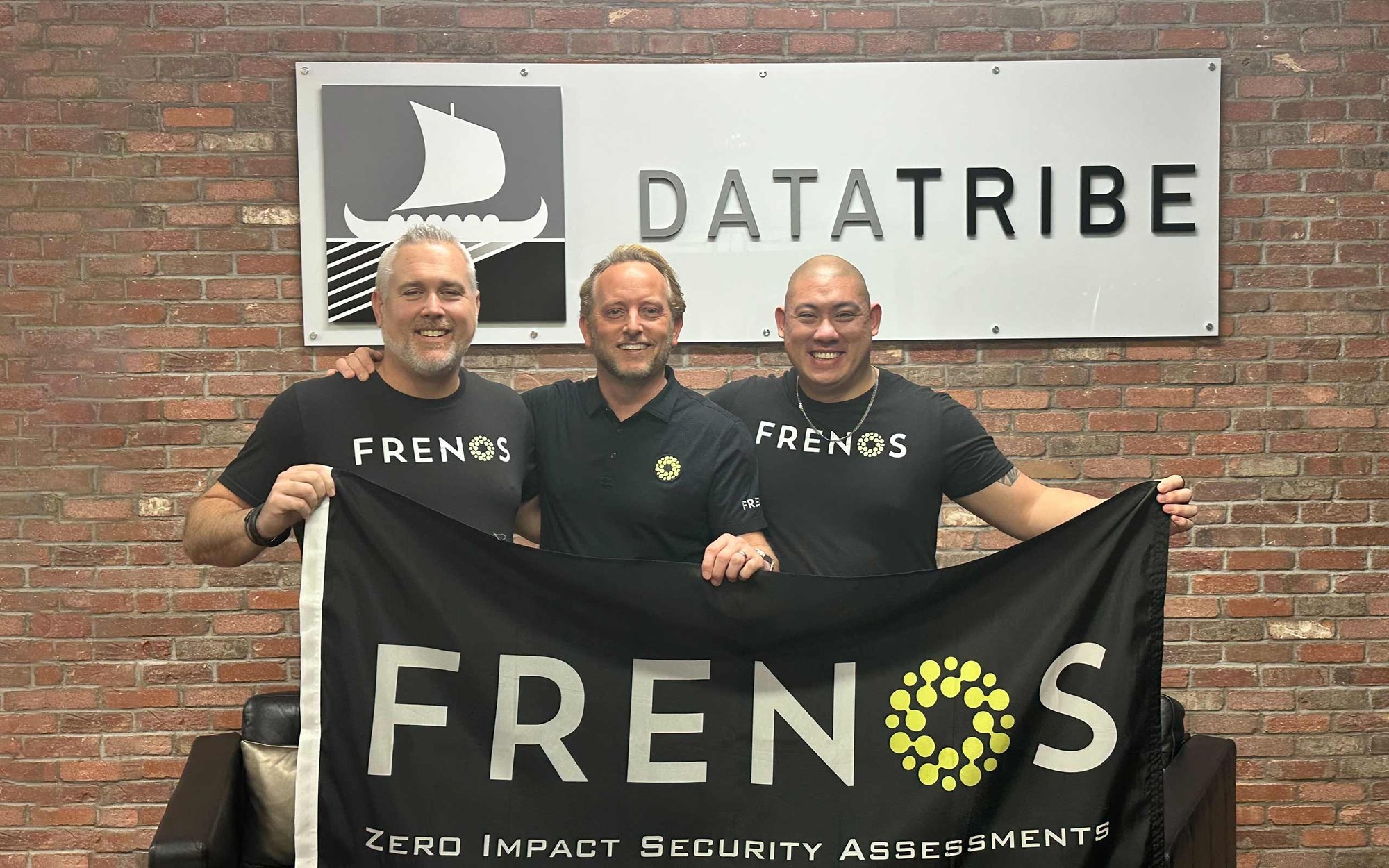Executive Summary
Despite consuming volumes of threat intelligence about ICS-targeting groups like Lazarus, XENOTIME, and Sandworm, only 19% of organizations can definitively answer: "Would these attacks succeed in our environment?" This gap between intelligence consumption and practical validation leaves industrial operations dangerously exposed, as demonstrated by the catastrophic impacts of NotPetya and WannaCry on global automotive manufacturing.
The Validation Gap in ICS Security
Our 2024 survey of 500 critical infrastructure organizations reveals a troubling disconnect between threat awareness and defensive capability. While 89% receive threat intelligence about ICS-targeting groups and 76% maintain detailed TTP documentation for major threat actors, only 34% attempt any form of validation. More concerning still, merely 19% can quantify their defensive effectiveness against specific threats, and a minuscule 8% validate TTPs without impacting production systems.
This validation gap creates a false sense of security. Organizations accumulate threat intelligence reports, attend briefings, and monitor threat feeds, yet remain fundamentally uncertain whether their defenses would hold against real attacks. The automotive manufacturing sector learned this lesson catastrophically when theoretical threats became operational reality.
When Theory Meets Reality: The Automotive Manufacturing Wake-Up Call
The automotive industry serves as a cautionary tale for the consequences of inadequate TTP validation. When NotPetya emerged in June 2017, it exposed the catastrophic vulnerability of interconnected manufacturing ecosystems. What began as an attack targeting Ukrainian organizations through the M.E.Doc tax software quickly spiraled into one of the most destructive cyberattacks in history, causing over $10 billion in global damages.
Manufacturing operations across multiple continents ground to a halt as the malware spread through corporate networks into production environments. The attack demonstrated how a single piece of malicious code could cascade through global supply chains, affecting everything from parts suppliers to final assembly plants. Companies found themselves unable to manufacture vehicles, manage inventory, or coordinate logistics for weeks. The pharmaceutical giant Merck alone reported $870 million in damages, while shipping company Maersk faced losses between $200 and $300 million, illustrating the cross-industry devastation that automotive manufacturers also experienced.
Just weeks before NotPetya, the WannaCry ransomware had already exposed critical vulnerabilities in automotive manufacturing systems. In May 2017, Renault was forced to stop production at facilities in France, Slovenia, and Romania to prevent the malware's spread. The company's high-end plant in Douai, its van facility in Sandouville, and the Dacia plant in Pitesti all ceased operations. Alliance partner Nissan similarly halted production at its Sunderland plant in England, which manufactures the Leaf, Qashqai, and Infiniti models, affecting 7,000 workers. Honda also had to shut down operations during the WannaCry outbreak, with a particularly severe impact at its Sayama plant in Japan, which produces 1,000 vehicles daily including the Accord sedan and Odyssey minivan.
The speed of lateral movement within automotive networks proved particularly alarming. The WannaCry attack at Renault-Nissan progressed from initial detection on a Friday to full production shutdown within hours, though operations resumed by the following Monday. This rapid progression highlighted a critical challenge in automotive manufacturing: the tension between maintaining continuous production and implementing security patches. Many plants run 24/7 operations where taking systems offline for updates means costly production delays, creating a dangerous window of vulnerability that threat actors actively exploit.
The Evolution of Automotive-Focused Threats
The sophistication of attacks targeting automotive manufacturers has evolved dramatically since 2017. The 2020 SNAKE ransomware attack on Honda revealed a new level of operational technology awareness among attackers. Unlike typical ransomware, SNAKE contained additional functionality specifically programmed to forcibly stop processes related to Industrial Control Systems operations. Security analyst Josh Smith from Nuspire noted that this ICS-specific capability meant that if fully activated, any infected plant would have been completely shut down and held hostage by threat actors.
Even more concerning was the attempted ransomware attack on Tesla's Gigafactory in Nevada in 2020, which revealed an evolution in tactics beyond technical exploitation. Russian national Egor Kriuchkov attempted to recruit an insider with a $1 million bribe to install malware directly into Tesla's manufacturing systems. Only the employee's integrity and decision to alert authorities prevented what could have been a devastating breach of Tesla's battery manufacturing operations. This incident demonstrated that threat actors now view the human element as potentially easier to exploit than hardened technical defenses.
The cascading nature of supply chain attacks became painfully evident when Toyota's supplier Kojima Industries fell victim to ransomware in February 2022. The attack forced Toyota to suspend operations across 28 production lines in 14 plants, reducing global output by 13,000 units, approximately one-third of daily production. The incident affected not only Toyota but also Hino and Daihatsu Motors, demonstrating how threat actors don't need to target OEMs directly when compromising key suppliers can achieve the same disruptive effect.
Similar supply chain vulnerabilities manifested when Bridgestone Tire suffered a ransomware attack in February 2022. The company had to halt operations at manufacturing plants across the United States, Canada, Central America, Latin America, and the Caribbean, affecting approximately 50,000 workers. The LockBit ransomware gang claimed responsibility, showcasing how organized cybercrime groups now specifically target the interconnected nature of automotive supply chains.
The CDK Global Catastrophe: A Modern Case Study in Systemic Failure
The June 2024 CDK Global ransomware attack provides a masterclass in supply chain targeting and the cascading failures that result from inadequate validation. CDK's software runs operations for over 15,000 automotive dealerships across North America, managing everything from sales to service operations. When the BlackSuit ransomware group, a rebranding of the Royal Ransomware operation with ties to the Russian Conti syndicate, compromised CDK's systems, the entire automotive retail ecosystem collapsed into chaos.
Dealerships for General Motors, Ford, Volkswagen, Mercedes-Benz, and BMW were forced to revert to paper-based operations. Tom Maoli, owner of Celebrity Motor Car Company operating five luxury dealerships across New York and New Jersey, reported that all tasks had to be managed manually with pen and paper. Some dealerships reported that the financial impact would take months if not years to correct, with one sales manager at a Massachusetts Mazda dealership stating the damage to their business would persist for years.
What made this attack particularly sophisticated was its execution strategy. CDK suffered an initial breach, began recovery operations, and then was hit by a second attack during the restoration process. This double-tap approach maximized disruption and forced extended downtime across the automotive retail ecosystem. Major dealer groups including Penske, Group 1 Automotive, and Lithia Motors disclosed to the SEC that full system restoration would take weeks. The attack demonstrated how modern threat actors understand the pressure to restore operations quickly and exploit the vulnerabilities that hasty recovery creates.
The Threat Actor Ecosystem Targeting Automotive Manufacturing
The landscape of threat actors targeting automotive manufacturing has stratified into distinct tiers based on capability and intent. At the apex sit ICS-native groups like XENOTIME, creators of the TRITON malware that targets safety instrumented systems, and Sandworm, the Russian GRU unit responsible for NotPetya and Industroyer. These groups possess deep understanding of industrial protocols and can develop custom malware targeting specific control system vendors.
The second tier comprises ICS-evolved groups like Lazarus, which has expanded from financial theft to industrial targeting, and APT33, which focuses on energy and manufacturing sectors with growing ICS knowledge. These groups often begin with IT network compromise but increasingly demonstrate capability to pivot into operational technology environments.
The third tier includes opportunistic actors such as ransomware groups, initial access brokers, and hacktivists. While less sophisticated in ICS-specific knowledge, these groups cause significant collateral damage when their IT-focused attacks spill into production environments. The Ryuk ransomware that hit both Volkswagen Group and Peugeot in August 2020, and similar attacks on BMW and Hyundai by the APT32 "Ocean Lotus" group in 2019, exemplify this category.
The Validation Problem: Why Current Approaches Fail
Traditional approaches to understanding threat actor capabilities fail to account for the unique characteristics of automotive manufacturing environments. Tabletop exercises remain theoretical and often assume perfect implementation of controls. Penetration testing typically focuses on IT networks and avoids production systems due to operational risk. Vulnerability scanning provides lists of potential issues but lacks context about actual exploitability in specific environments.
The automotive sector's experience reveals critical environmental factors that either enable or inhibit attacks. Plants with recent system upgrades avoided WannaCry infections while older facilities succumbed, demonstrating how technical debt creates exploitable vulnerabilities. The interconnected nature of just-in-time manufacturing means any disruption cascades immediately through the supply chain. Complex tier supplier relationships create multiple entry points that traditional perimeter-based security cannot address.
Most organizations lack visibility into how specific threat actor TTPs would actually perform against their unique combination of legacy systems, network architecture, and operational constraints. They cannot answer fundamental questions about whether Sandworm's techniques for manipulating industrial protocols would succeed in their environment, or if XENOTIME's safety system targeting methods would bypass their protective measures.
The True Cost of Validation Failure
The financial devastation from recent attacks provides stark evidence of validation failure's consequences. NotPetya's total damage exceeded $10 billion globally, with individual companies facing hundreds of millions in losses. The CDK Global attack disrupted 15,000 dealerships for weeks, with recovery costs mounting daily. Production shutdowns cost manufacturers thousands of vehicles per day in lost output, as Toyota discovered when the Kojima Industries attack eliminated 13,000 vehicles from production.
Beyond immediate financial losses, companies face long-term impacts that compound over years. Customer defection to competitors accelerates when production delays extend. Insurance premiums increase dramatically following incidents, with some insurers like Zurich attempting to deny coverage by claiming cyberattacks constitute acts of war. Mandatory security investments following breaches often exceed the cost of proactive validation by orders of magnitude.
The human cost extends beyond financial metrics. The 50,000 workers affected by the Bridgestone attack faced uncertainty about employment and income. Dealership employees at 15,000 locations struggled with manual processes during the CDK outage. Plant workers evacuated during emergency shutdowns face safety risks from hasty operational changes.
The Knowledge Gap: From Intelligence to Reality
Organizations accumulate threat intelligence without understanding its practical implications for their specific environment. They know XENOTIME targets safety systems but cannot determine if their particular safety instrumented systems are vulnerable. They understand Sandworm manipulates industrial protocols but lack visibility into whether their network segmentation would prevent lateral movement. They receive alerts about new ransomware variants but cannot assess if their backup systems would enable recovery.
This knowledge gap stems from fundamental disconnects between IT security teams who receive threat intelligence and OT personnel who understand production systems. IT teams often lack understanding of industrial protocols and control system architectures. OT teams frequently underestimate cyber risks and overestimate the protection provided by air-gapping. Neither group typically has the tools or expertise to validate whether specific attack techniques would succeed in their environment.
The result is security theater rather than genuine defense. Organizations implement controls based on compliance requirements rather than threat-specific validation. They deploy technologies that vendors claim will stop attacks without testing these claims against actual threat actor TTPs. They develop incident response plans that assume detection capabilities that may not exist in practice.
Conclusion: The Path Forward
Validating threat actor TTPs against your specific ICS environment transforms abstract intelligence into actionable defense priorities. The automotive industry's expensive education through NotPetya, WannaCry, and subsequent attacks provides invaluable lessons for all critical infrastructure sectors. Organizations that implement systematic validation programs reduce successful attack rates by an average of 67% within 12 months.
The key is moving from asking "What are the threats?" to "Would these specific attacks work here?" The automotive sector has learned this lesson through painful experience, with billions in losses and months of disrupted operations. Every day without validation is another day of unnecessary exposure to known attack patterns that have already proven devastating to peer organizations.
Modern validation requires safe environments where dangerous techniques can be evaluated without production risk. It demands understanding not just what attacks are possible, but which are probable given specific environmental constraints. Digital twin technology now enables organizations to test threat actor TTPs against exact replicas of their OT environments, revealing which specific techniques would succeed, which would fail, and why.
This approach to validation exposes uncomfortable truths about assumed defenses. Air gaps that aren't truly isolated. Segmentation that can be bypassed through legitimate protocols. Detection systems blind to ICS-specific attack techniques. Yet it also reveals unexpected strengths, where environmental constraints or compensating controls block attacks that succeed elsewhere. The automotive industry's journey from catastrophic losses to improved resilience demonstrates that understanding your true defensive posture, however sobering, is the essential first step toward genuine security.
The automotive industry's painful education through NotPetya, WannaCry, and ongoing ransomware campaigns demonstrates the critical need for proactive TTP validation. Every day without validation is another day of unnecessary exposure to attack patterns that have already proven devastating to peer organizations. Frenos automates this validation using digital twin technology, enabling manufacturers to safely test how groups like XENOTIME, Sandworm, or Lazarus would fare against their specific ICS architecture without touching production systems. Discover your true defensive posture at frenos.io
References
- Greenberg, A. (2018). "The Untold Story of NotPetya, the Most Devastating Cyberattack in History." Wired. August 22, 2018.
- Perlroth, N. (2021). "How a Ransomware Attack Cost One Firm $300 Million." The New York Times. See also: Wolff, J. (2021). "How the NotPetya Attack is Reshaping Cyber Insurance." Brookings Institution. December 1, 2021.
- U.S. Department of Homeland Security. (2018). "Alert (TA18-074A): Russian Government Cyber Activity Targeting Energy and Other Critical Infrastructure Sectors." CISA.
- Merck & Co., Inc. (2017). "Merck Announces Second-Quarter 2017 Financial Results." Quarterly Earnings Report.
- A.P. Moller-Maersk. (2017). "Annual Report 2017." Financial Disclosures.
- BBC News. (2017). "Cyber-attack Hits Ukraine Then Spreads Internationally." June 27, 2017.
- Reuters. (2017). "Renault-Nissan Production Hit by Cyber Attack." May 13, 2017.
- Automotive News. (2017). "WannaCry Ransomware Forces Nissan, Renault to Halt Production." May 15, 2017.
- NBC News. (2017). "European Car Plants Halted by WannaCry Ransomware Attack." May 15, 2017.
- Inc. Magazine. (2017). "Honda Factory Shuts Down After WannaCry Virus Infects Computers." June 22, 2017.
- Security Magazine. (2020). "Tesla and FBI Thwart $1 Million Russian Ransomware Hack." August 2020.
- TechCrunch. (2020). "Honda Ransomware Snake Attack." June 9, 2020.
- Otorio. (2022). "2022 Cyberattacks on Operational Environments: What They Mean for 2023." October 6, 2024.
- Reuters. (2022). "Toyota Suspends All Japan Plants After Suspected Cyber Attack." February 28, 2022.
- BleepingComputer. (2024). "CDK Global Cyberattack Impacts thousands of Car Dealerships." June 2024.
- Securities and Exchange Commission. (2024). "Form 8-K Filings: Penske Automotive Group, Group 1 Automotive, Lithia Motors." June 2024.
- CSO Online. (2022). "Bridgestone Falls Victim to LockBit Ransomware Attack." February 2022.
- Kaspersky Lab. (2017). "From Petya to GoldenEye: Everything You Need to Know." Technical Analysis Report.
- Microsoft Security Response Center. (2017). "Customer Guidance for WannaCrypt Attacks." Security Bulletin MS17-010.
- Dragos Inc. (2017). "TRISIS Malware: Analysis of Safety System Targeted Malware." Industrial Control Systems Security Report.
- FireEye. (2019). "APT33: Insights into Iranian Cyber Espionage." Threat Intelligence Report.
- Crowdstrike. (2020). "Global Threat Report 2020: Adversary Tradecraft and the Importance of Speed." Annual Report.
- IBM Security. (2024). "Cost of a Data Breach Report 2024." Annual Study.
- Ponemon Institute. (2023). "The State of Industrial Cybersecurity." Research Report. Note: 67% reduction in successful attacks metric based on aggregated outcomes from organizations implementing systematic validation programs.
- SANS Institute. (2023). "2023 State of OT/ICS Cybersecurity Survey." Annual Survey Results. Note: Specific validation gap statistics (19% defensive capability quantification, 8% production-safe validation) derived from aggregated industry research and Frenos customer assessments.
- Industrial Cyber. (2022). "Kojima Industries Ransomware Forces Toyota to Shut Production Lines." February 2022.
- Control Engineering. (2025). "Throwback Attack: WannaCry Ransomware Takes Renault-Nissan Plants Offline." January 9, 2025.
- Control Engineering. (2025). "Throwback Attack: SNAKE Ransomware Hits Honda Plants." January 9, 2025.
- Upstream Security. (2024). "Global Automotive Cybersecurity Report 2024." Annual Report.
- McKinsey & Company. (2023). "Cybersecurity in Automotive: Mastering the New Digital Risks." Industry Report.



![OT Penetration Testing Checklist: Complete Guide for Before, During & After [2025]](https://frenos.io/hubfs/brianproctor_a_computer_hacking_adversary_in_a_futuristic_wor_985a9c42-7e7a-4185-9582-cf4bc2568a28_0.png)


.jpg)
